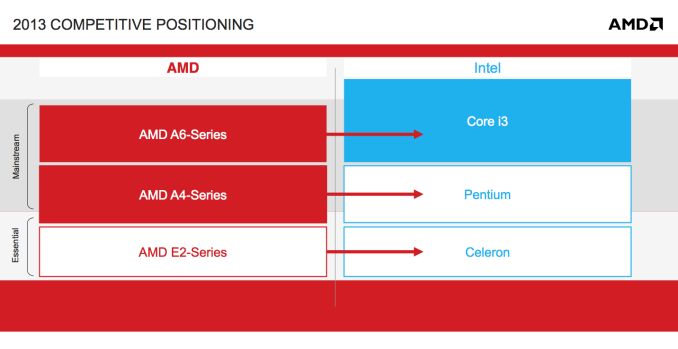The Kabini Deal: Can AMD Improve the Quality of Mainstream PCs with Its Latest APU?
by Anand Lal Shimpi on May 24, 2013 1:45 PM EST
There are two non-negotiables in building a PC these days: the cost of Intel silicon and the cost of the Windows license. You can play with everything else but Intel and Microsoft are going to get their share. Those two relatively fixed costs in the PC bill of materials can do one of two things: encourage OEMs to skimp on component cost elsewhere, or drive the entire ecosystem to supply higher quality components at lower prices. If you’ve been following the PC industry for the past decade, I think we’ve seen more of the former and less of the latter.
Apple occupying the high-end of the notebook PC space has forced many OEMs to reconsider their approach, but that’s a more recent change. What AMD seems to offer is an easier path. AMD will take less of the BoM, allowing OEMs to invest those savings elsewhere - a move Intel will never make. Given how much pressure the PC OEMs have been under for the past few years, AMD’s bargain is more appealing now than it has ever been.
With Llano and Trinity, AMD’s story was about giving up CPU performance for GPU performance. With Kabini, the deal is more palatable. You only give up CPU performance compared to higher priced parts (you gain performance compared to Atom), and you get much lower power silicon that can run in thinner/lighter notebooks. Typically at the price points Kabini is targeting (sub-$400 notebooks), you don’t get pretty form factors with amazing battery life. AMD hopes to change that.
While AMD hasn’t disclosed OEM pricing on Kabini (similarly, Intel doesn’t list OEM pricing on its mobile Pentium SKUs), it’s safe to assume that AMD will sell Kabini for less than Intel will sell its competing SKUs. If Kabini’s die size is indeed around 107mm^2, that puts it in the same range as a dual-core Ivy Bridge. AMD can likely undercut Intel a bit and live off of lower margins, but there’s one more component to think about: Ivy Bridge needs its PCH (Platform Controller Hub), Kabini does not. As a more fully integrated SoC, Kabini’s IO duties are handled by an on-die Fusion Controller Hub. Intel typically charges low double digits for its entry level chipsets, which is money AMD either rolls into the cost of Kabini or uses as a way of delivering a lower total cost to OEMs.
Traditionally, OEMs would take these cost savings and pass them along to the end user. I get the impression that AMD’s hope with Kabini is for OEMs to instead take the cost savings and redeploy them elsewhere in the system. Perhaps putting it towards a small amount of NAND on-board for a better user experience, or maybe towards a better LCD.
As we found in yesterday’s article, Kabini does a great job against Atom and Brazos. However, even with double digit increases in performance, Kabini is still a little core and no match for the bigger Ivy Bridge parts. Much to our disappointment, we pretty much never get sent low end hardware for review - so to make yesterday’s NDA we had to stick with 17W Ivy Bridge and extrapolate performance from there. In the past day I grabbed an ASUS X501A system, a 15-inch entry-level machine priced in the low $300s. More importantly, it features a 35W Ivy Bridge based Pentium CPU: the dual-core 2020M.
The Pentium 2020M’s base clock speed is still relatively high at 2.4GHz, but there’s no turbo. In the low level CPU performance analysis yesterday I used a Surface Pro with a 17W 1.7GHz Core i5, but max turbo on that part can hit 2.6GHz. I actually don’t expect there to be huge CPU performance differences between the results from yesterday and what I have here but I wanted to be sure.
The bigger difference is actually on the GPU side. While a mobile Core i5 comes with Intel’s HD 4000 graphics, the Pentium 2020M gets a vanilla Intel HD GPU. At 22nm, Intel’s HD graphics is a 6 EU part with lower performance than the previous generation Intel HD 3000.
With that said, let’s see how Kabini (AMD’s A4-5000 in particular) compares to an Ivy Bridge based Pentium 2020M in CPU performance, GPU performance and finally in power.











108 Comments
View All Comments
Gaugamela - Saturday, May 25, 2013 - link
I'm fully aware that Kabini can't beat an i3. But you should also be fully aware that AMD in their slides doesn't point the A4-5000 as competing with i3 Ivy Bridge but with Pentiums. They mention the 25W A6 as competition for the i3's. Would that APU be competitive with the i3 still in performance/power consumption/GPU/price? I remain a bit more skeptical of that. Will the OEMs use it in compelling designs instead of using it in the crappiest notebooks in the market? I certainly hope so, just like you.As for what the OEMs do, the only one that used a AMD APU in a premium case was Asus with their U38N and U38DT. It's a 13,3'' Zenbook with Trinity APUs. It has a Full HD multi-touch IPS displays, aluminum body, and offers a lower price than comparable ultrabooks from Intel (obviously with lower CPU performance). I would expect for a Kabini/Richland refresh though. What I would love to see, is if you want that type of notebooks so much ask OEMs to send them to you for review if they're available.
In my case, I am not blind and if I had to pick a cheap notebook I would go for the Asus x202e. I always go for high performance notebooks (that's why my picks have always been Intel/Nvidia notebooks). However, while you may get the Asus x202e in the US for 400$ in my country it's available for 600€! A comparable Kabini notebook would cost probably 400-450€ since it doesn't have the Intel sticker.
JarredWalton - Saturday, May 25, 2013 - link
Not sure if you get Vizio offerings, but Vizio looks to have some compelling Richland (maybe Kabini as well?) touchscreen laptops launching soon. We'll certainly try to get them, but sadly a lot of OEMs are very particular over what laptops they send for review, hence the lack of i3 ULV, Pentium, Celeron, Trinity ULV, etc. If I had the money, I'd just go buy the damn things for review, but that's not generally practical.Gaugamela - Saturday, May 25, 2013 - link
Unfortunately there's no Vizio offerings in Europe. :(They are beautiful and seem to be one of the few OEMs that use AMD APUs in atractive designs similar to Intel ultrabooks.
With the trend that we are seeing, it would be interesting to see more reviews of low-power APUs.
kyuu - Monday, May 27, 2013 - link
Do they? The recent refresh used Trinity, and they haven't even started shipping the 14" Trinity model yet. Plus the prices ballooned to over a grand for the cheapest model.Is there another refresh coming up?
dbwells - Friday, May 24, 2013 - link
I think the big story here is that AMD is meeting and sometimes besting Intel IVB parts on performance per watt. I cannot remember the last time that happened. Or am I misunderstanding something? If they can scale up Jaguar, they might really have something here. It's kinda like the second coming of Core, while Barcelona and its progeny are the corresponding repeat of NetBurst.Bobs_Your_Uncle - Friday, May 24, 2013 - link
My take-away is much the same as yours: AMD is punching it's way back into the game, which now also happens to feature more, (as well as many more moving), targets. (The "moving ≈ mobile ≈ more rapidly paced product cycle" pun is intended, though as I've advised my kids, if you have to explain it, well then it's just not funny!)I'm a relative late comer to the ranks of tech obsessed / tech aficionados. Since my arrival, maybe 4-5 years ago, Intel has always been the widely dominant force, though I always enjoy rooting for an underdog; in this case AMD.
My desire to root for AMD has increased significantly within the last couple of months, due in large part to several Anand-authored profiles on new arrivals, or employees returning, to AMD. This rationale for wishing AMD well was further solidified by a brief history of AMD, written by Andrew Cunningham & posted in Ars Technica at the following link:
http://arstechnica.com/business/2013/04/amd-on-rop...
Lacking extensive personal knowledge with which to gauge or critique the article, it at least gave me a greater sense of the significant role occupied by AMD & their summary impact within the industry. With some much valued platform infrastructure still in place, the recent influx of quite formidable talent & experience is, I think, cause for at least guarded optimism over AMD's fortunes.
tipoo - Saturday, May 25, 2013 - link
The scale up is easier said than done, scaling down is much easier. Jaguar can only clock to 2GHz due to the architecture, they'd have to significantly change it to scale that up, and once they do the IPC may suffer.nunomoreira10 - Saturday, May 25, 2013 - link
Your right, if they could just double the performance per core, doubling everything, they could have a great mobile cpu for everything. they sure have an exess of tdp to use.I always wonder how hard it would be to do that, but im sure it´s easier to say then do.
takeship - Friday, May 24, 2013 - link
Any chance Anand that you could swap some performance memory in for that single stick, say something with 8-8-8 24 or 9-9-9 27 timings, and see if we get any graphical boost out of ti?woofersus - Friday, May 24, 2013 - link
I wonder if we could see one of these in a lower priced x86 Surface, given the market's clear preference for the full version of Windows and the high price of the original Surface Pro. Seems like a Kabini chip could make for a nice intermediary.